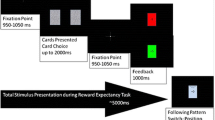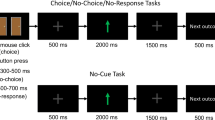Abstract
What if the brain’s response to reward occurs even when there is no reward? Wouldn’t that be a further concern for people prone to problem gambling and other forms of addiction, like those related to eating? Electroencephalography was employed to investigate this possibility using probabilistic feedback manipulations and measures of known event-related potentials (ERPs) related to reward processing. We tested the hypothesis—that reward-based ERPs would occur even in the absence of a tangible reward and when manipulations on expectation are implicit. The well-known P300 response potential was a key focus, and was assessed in non-gambling volunteer undergraduates on a task involving experimentally-manipulated probabilities of positive or negative feedback comprising three trial types—80, 50, or 20% positive feedback. A feedback stimulus (F1) followed a guess response between two possible outcomes (implicit win/loss), and then a second feedback stimulus (F2) was presented to confirm an alleged ‘win’ or ‘loss’ (explicit win/loss). Results revealed that amplitude of the P300 in F1-locked data (implicit manipulation) was larger (more positive) on average for feedback outcomes that were manipulated to be less likely than expected. The effect is pronounced after increased time on task (later trials), even though the majority of participants were not explicitly aware of our probability manipulations. For the explicit effects in F2-locked data, no meaningful or significant effects were observed. These findings point to the existence of proposed success-response mechanisms that operate not only explicitly but also with implicit manipulations that do not involve any direct indication of a win or loss, and are not associated with tangible rewards. Thus, there seems to be a non-explicit form of perception (we call ‘implicit’) associated with an internal experience of wins/losses (in the absence of actual rewards or losses) that can be measured in associated brain processes. The potential significance of these findings is discussed in terms of implications for problem gambling.




Similar content being viewed by others
References
Aine, C. J. (1994). A conceptual overview and critique of functional neuroimaging techniques in humans: I. MRI/FMRI and PET. Critical Reviews in Neurobiology, 9(2–3), 229–309.
American Psychiatric Association. (2013). Diagnostic and statistical manual of mental disorders (DSM-5 ® ). Arlington: American Psychiatric Association Publishing.
Bednark, J. G., & Franz, E. A. (2014). Agency attribution: Event-related potentials and outcome monitoring. Experimental Brain Research, 232(4), 1117–1126.
Bednark, J. G., Reynolds, J. N. J., Stafford, T., Redgrave, P., & Franz, E. A. (2013). Creating a movement heuristic for voluntary action: Electrophysiological correlates of movement-outcome learning. Cortex, 49(3), 771–780.
Bednark, J. G., Reynolds, J. N. J., Stafford, T., Redgrave, P., & Franz, E. A. (2016). Action experience and action discovery in medicated individuals with Parkinson’s disease. Frontiers in Human Neuroscience, 10.
Bondolfi, G., Osiek, C., & Ferrero, F. (2000). Prevalence estimates of pathological gambling in Switzerland. Acta Psychiatrica Scandinavica, 101(6), 473–475.
Caplin, A., Dean, M., Glimcher, P. W., & Rutledge, R. B. (2010). Measuring beliefs and rewards: A neuroeconomic approach. The Quarterly Journal of Economics, 125(3), 923–960.
Cohen, M. X., Elger, C. E., & Ranganath, C. (2007). Reward expectation modulates feedback-related negativity and EEG spectra. Neuroimage, 35(2), 968–978.
Comings, D., Gade-Andavolu, R., Gonzalez, N., Wu, S., Muhleman, D., Chen, C. E., et al. (2001). The additive effect of neurotransmitter genes in pathological gambling. Clinical Genetics, 60(2), 107–116.
Courchesne, E., Hillyard, S. A., & Courchesne, R. Y. (1977). P3 waves to the discrimination of targets in homogeneous and heterogeneous stimulus sequences. Psychophysiology, 14(6), 590–597.
Debnath, R., & Franz, E. A. (2016). Perception of hand movement by mirror reflection evokes brain activation in the motor cortex contralateral to a non-moving hand. Cortex, 81, 118–125.
Delorme, A., & Makeig, S. (2004). EEGLAB: an open source toolbox for analysis of single-trial EEG dynamics including independent component analysis. Journal of Neuroscience Methods, 134(1), 9–21.
Eitam, B., Kennedy, P. M., & Higgins, E. T. (2013). Motivation from control. Experimental Brain Research, 229(3), 475–484.
Eriksen, B. A., & Eriksen, C. W. (1974). Effects of noise letters upon the identification of a target letter in a nonsearch task. Attention, Perception, and Psychophysics, 16(1), 143–149.
Feigelman, W., Kleinman, P. H., Lesieur, H. R., Millman, R. B., & Lesser, M. L. (1995). Pathological gambling among methadone patients. Drug and Alcohol Dependence, 39(2), 75–81.
Franz, E. A., & Fu, Y. (2017). Pre-movement planning processes in people with congenital mirror movements. Clinical Neurophysiology, 128, 1985–1993.
Franz, E. A., Fu, Y., Moore, M., Winter, T., Mayne, T., Debnath, R., et al. (2016). Fooling the brain by mirroring the hand: Brain correlates of the perceptual capture of limb ownership. Restorative Neurology and Neuroscience, 34(5), 721–732.
Franz, E. A., & Miller, J. (2002). Effects of response readiness on reaction time and force output in people with Parkinson’s disease. Brain, 125, 1733–1750.
Galvan, A., Hare, T. A., Davidson, M., Spicer, J., Glover, G., & Casey, B. (2005). The role of ventral frontostriatal circuitry in reward-based learning in humans. Journal of Neuroscience, 25(38), 8650–8656.
Gehring, W. J., Coles, M. G., Meyer, D. E., & Donchin, E. (1995). A brain potential manifestation of error-related processing. Electroencephalography and Clinical Neurophysiology-Supplements Only, 44, 261–272.
Gehring, W. J., Goss, B., Coles, M. G., Meyer, D. E., & Donchin, E. (1993). A neural system for error detection and compensation. Psychological Science, 4(6), 385–390.
Gneezy, U., & Rustichini, A. (2000). Pay enough or don’t pay at all. The Quarterly Journal of Economics, 115(3), 791–810.
Hajcak, G., Holroyd, C. B., Moser, J. S., & Simons, R. F. (2005). Brain potentials associated with expected and unexpected good and bad outcomes. Psychophysiology, 42(2), 161–170.
Hall, G. W., Carriero, N. J., Takushi, R. Y., Montoya, I. D., Preston, K. L., & Gorelick, D. A. (2000). Pathological gambling among cocaine-dependent outpatients. American Journal of Psychiatry, 157(7), 1127–1133.
Holroyd, C. B., & Coles, M. G. (2002). The neural basis of human error processing: Reinforcement learning, dopamine, and the error-related negativity. Psychological Review, 109(4), 679–709.
Holroyd, C. B., Nieuwenhuis, S., Yeung, N., & Cohen, J. D. (2003). Errors in reward prediction are reflected in the event-related brain potential. NeuroReport, 14(18), 2481–2484.
Ito, T. A., Larsen, J. T., Smith, N. K., & Cacioppo, J. T. (1998). Negative information weighs more heavily on the brain: the negativity bias in evaluative categorizations. Journal of Personality and Social Psychology, 75(4), 887–900.
Johnson, R., & Donchin, E. (1980). P300 and stimulus categorization: Two plus one is not so different from one plus one. Psychophysiology, 17(2), 167–178.
Knutson, B., Adams, C. M., Fong, G. W., & Hommer, D. (2001). Anticipation of increasing monetary reward selectively recruits nucleus accumbens. Journal of Neuroscience, 21(16), 159.
Mognon, A., Jovicich, J., Bruzzone, L., & Buiatti, M. (2011). ADJUST: An automatic EEG artifact detector based on the joint use of spatial and temporal features. Psychophysiology, 48(2), 229–240.
Nakahara, D., Ozaki, N., Miura, Y., Miura, H., & Nagatsu, T. (1989). Increased dopamine and serotonin metabolism in rat nucleus accumbens produced by intracranial self-stimulation of medial forebrain bundle as measured by in vivo microdialysis. Brain Research, 495(1), 178–181.
Oberg, S. A., Christie, G. J., & Tata, M. S. (2011). Problem gamblers exhibit reward hypersensitivity in medial frontal cortex during gambling. Neuropsychologia, 49(13), 3768–3775.
Pavlov, I. (1903). 1928 Lectures on conditioned reflexes (W. H. Gantt, Trans.). New York: International.
Pavlov, I. P., & Anrep, G. V. E. (1927). Conditioned reflexes: An investigation of the physiological activity of the cerebral cortex (Translated and Edited by G. V. Anrep). London.
Polich, J. (2007). Updating P300: An integrative theory of P3a and P3b. Clinical Neurophysiology, 118(10), 2128–2148.
Sato, A., Yasuda, A., Ohira, H., Miyawaki, K., Nishikawa, M., Kumano, H., et al. (2005). Effects of value and reward magnitude on feedback negativity and P300. NeuroReport, 16(4), 407–411.
Volberg, R. A., Abbott, M. W., Rönnberg, S., & Munck, I. M. (2001). Prevalence and risks of pathological gambling in Sweden. Acta Psychiatrica Scandinavica, 104(4), 250–256.
Wu, Y., & Zhou, X. (2009). The P300 and reward valence, magnitude, and expectancy in outcome evaluation. Brain Research, 1286, 114–122.
Yeung, N., & Sanfey, A. G. (2004). Independent coding of reward magnitude and valence in the human brain. Journal of Neuroscience, 24(28), 6258–6264.
Acknowledgements
Thanks to D. Fielding, Rev. J. Fielding, C. Wu, and A. Pirola-Merlo for helpful comments and discussion.
Author information
Authors and Affiliations
Corresponding author
Ethics declarations
Conflict of interest
No authors have any conflicts of interest.
Ethical Approval
All procedures performed in studies involving human participants were in accordance with the ethical standards of the institutional committee (University of Otago Ethics Committee) and with the 1964 Helsinki declaration and its later amendments or comparable ethical standards.
Rights and permissions
About this article
Cite this article
Fielding, A., Fu, Y. & Franz, E.A. The Brain’s Reward Response Occurs Even Without Actual Reward!. J Gambl Stud 34, 449–463 (2018). https://doi.org/10.1007/s10899-017-9721-3
Published:
Issue Date:
DOI: https://doi.org/10.1007/s10899-017-9721-3




